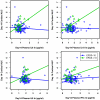Bidirectional psychoneuroimmune interactions in the early postpartum period influence risk of postpartum depression
- PMID: 25937051
- PMCID: PMC4567438
- DOI: 10.1016/j.bbi.2015.04.012
Bidirectional psychoneuroimmune interactions in the early postpartum period influence risk of postpartum depression
Abstract
More than 500,000 U.S. women develop postpartum depression (PPD) annually. Although psychosocial risks are known, the underlying biology remains unclear. Dysregulation of the immune inflammatory response and the hypothalamic-pituitary-adrenal (HPA) axis are associated with depression in other populations. While significant research on the contribution of these systems to the development of PPD has been conducted, results have been inconclusive. This is partly because few studies have focused on whether disruption in the bidirectional and dynamic interaction between the inflammatory response and the HPA axis together influence PPD. In this study, we tested the hypothesis that disruption in the inflammatory-HPA axis bidirectional relationship would increase the risk of PPD. Plasma pro- and anti-inflammatory cytokines were measured in women during the 3rd trimester of pregnancy and on Days 7 and 14, and Months 1, 2, 3, and 6 after childbirth. Saliva was collected 5 times the day preceding blood draws for determination of cortisol area under the curve (AUC) and depressive symptoms were measured using the Edinburgh Postpartum Depression Survey (EPDS). Of the 152 women who completed the EPDS, 18% were depressed according to EDPS criteria within the 6months postpartum. Cortisol AUC was higher in symptomatic women on Day 14 (p=.017). To consider the combined effects of cytokines and cortisol on predicting symptoms of PPD, a multiple logistic regression model was developed that included predictors identified in bivariate analyses to have an effect on depressive symptoms. Results indicated that family history of depression, day 14 cortisol AUC, and the day 14 IL8/IL10 ratio were significant predictors of PPD symptoms. One unit increase each in the IL8/IL10 ratio and cortisol AUC resulted in 1.50 (p=0.06) and 2.16 (p=0.02) fold increases respectively in the development of PPD. Overall, this model correctly classified 84.2% of individuals in their respective groups. Findings suggest that variability in the complex interaction between the inflammatory response and the HPA axis influence the risk of PPD.
Keywords: Cortisol; Cytokines; Cytokine–cortisol feedback circuit; Inflammation; Postpartum depression; Psychoneuroimmune.
Copyright © 2015 Elsevier Inc. All rights reserved.
Figures

References
-
- Aagaard-Tillery KM, Silver R, Dalton J. Immunology of normal pregnancy. Semin Fetal Neonatal Med. 2006;11:279–295. - PubMed
-
- Albacar G, Sans T, Martin-Santos R, Garcia-Esteve L, Guillamat R, Sanjuan J, Canellas F, Carot JM, Gratacos M, Bosch J, et al. Thyroid function 48h after delivery as a marker for subsequent postpartum depression. Psychoneuroendocrinology. 2010;35:738–742. - PubMed
-
- Anisman H, Merali Z. Cytokines, stress and depressive illness: brain-immune interactions. Ann Med. 2003;35:2–11. - PubMed
-
- Association AP. Diagnostic and statistical manual of mental disorders. 5th ed American Psychiatric Publishing; Arlington, VA: 2013.
Publication types
MeSH terms
Substances
Grants and funding
LinkOut - more resources
Full Text Sources
Other Literature Sources
Medical

